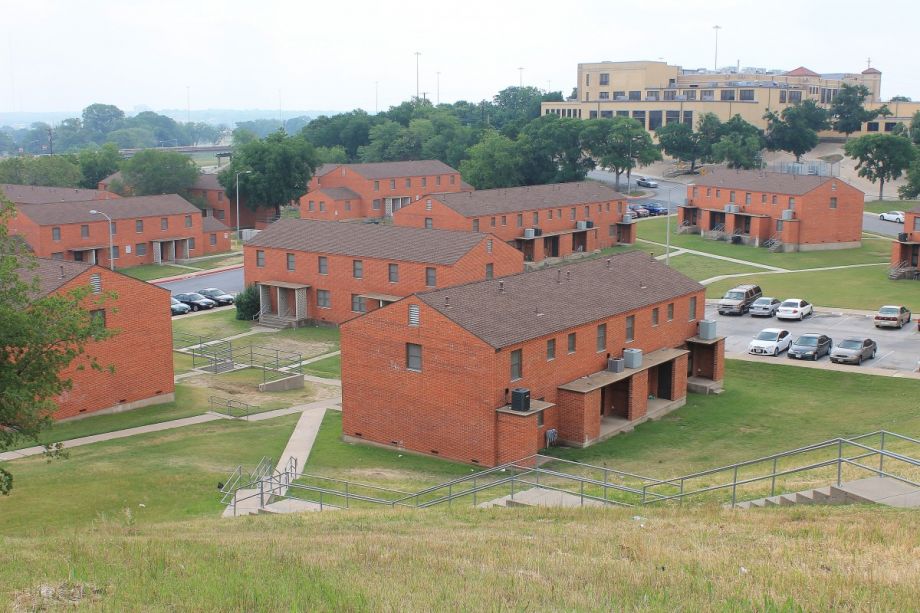On a two-acre park-and-ride lot and bus stop, in the South Main Village area Fort Worth, Texas, plans are underway to build the city’s first transit-oriented development. The $94.3 million project, to include apartments, retail and potentially a boutique hotel, will have direct access to the Trinity Railway Express and the 27-mile TEXRail line to the Dallas-Fort Worth international airport, set to open later this year.
The apartment building will hold market-rate and rent-restricted housing, including apartments reserved for residents being relocated from Butler Place, the city’s largest public housing complex, which is slated for a complete overhaul into a mixed-use, potentially mixed-income development.
Located about a mile away, Butler Place is one of 52 public housing complexes built as part of the former Works Progress Administration’s work-relief program in the 1930s-40s. The low-slung brick buildings, surrounded by a maze of highways, have long fallen into disrepair. The relocation of its residents is part of a major undertaking by Fort Worth Housing Solutions, the city’s public housing authority, to convert its portfolio of public housing under the Rental Assistance Demonstration (RAD) program, a voluntary program of the Department of Housing and Urban Development (HUD), authorized by Congress in 2012.
Under RAD, all of the nearly 1,000 residents living in Butler Place will be relocated to newer, mixed-use and mixed-income developments like the one planned in South Main Village. After the Butler Place overhaul, under the RAD program rules, previous residents will have first dibs on apartments in the overhauled complex.
The city’s public housing agency has taken the RAD program as an opportunity to overhaul itself — established in 1938 as the Housing Authority of the City of Fort Worth — not just in terms of its name, but the type of affordable housing it oversees.
“We were an early adopter [of RAD],” says Mary-Margaret Lemons, president of Fort Worth Housing Solutions. “It’s the model we’re using to deconcentrate poverty, so we won’t have large concentrations of public housing like we do today.”
The RAD program works by transferring public housing units into private sector management under long-term, project-based Section 8 contracts. Tenants pay the same 30 percent of their monthly income in rent that they pay under public housing. Local public housing authorities maintain the ability to place tenants through their lottery systems and waiting lists, while private developers receive rental income (based on a locally-based fair-market calculation by HUD). The partnership between developers and housing authorities allows access to a broader range of subsidies and financing to rehabilitate and manage affordable housing.
A number of housing authorities across the country have come to see RAD as necessary given Congress’s refusal to adequately fund public housing and billions of dollars needed for backlogged repairs.
“There’s been a lot of interest by housing authorities, in large part because there are few other options to preserve public housing properties,” says Jessica Cassella, a staff attorney with the National Housing Law Project.
Under RAD, some cities, like NYC or San Francisco, have chosen to preserve the buildings they have, converting them wholesale into project-based Section 8 properties in partnership with developers. Out of concern for potential displacement of residents, San Francisco chose to work only with nonprofit developers like the Mission Economic Development Agency. NYC is using its RAD program as a boost for local jobs and local minority and women contractors.
In this changing landscape, Fort Worth’s housing authority is moving from an owned-and-operated property model to an asset management and property development business model with the help of private entities, facilitated by RAD. According to Fort Worth Housing Solutions, it’s the largest public housing authority in Texas to convert its entire portfolio under the program.
The need for affordable housing has only increased over the years in Fort Worth, according to Lemons. In the early years of RAD, the agency took a hard look at areas across the city it could build more, alongside the nonprofit Downtown Fort Worth, Inc. The Butler Place complex, which spans 42 acres near downtown Fort Worth, stood out.
“We were pouring over maps, looking for parcels downtown where it made sense to pursue affordable housing,” says Andy Taft, president of Downtown Fort Worth, Inc. “It struck us that [Fort Worth Housing Solutions] owned 42 acres adjacent to downtown, so we started paying attention to ways we could use that land more effectively. That led to RAD, and rethinking the fate of Butler Place.”
But before the city turns to the redevelopment of Butler Place — likely to be a mixed-use project with market-rate apartments alongside Section 8 units — Fort Worth Housing Solutions made it “our first priority to get our residents relocated,” says Lemons. Fifteen families moved this December to Stallion Pointe, a new 264-unit mixed-income development. The goal, according to Lemons, is to relocate everyone from Butler Place by the end of 2020.
The RAD relocation process has emerged as a major concern to housing advocates, according to Cassella. “The program is very complicated and has a lot of moving parts,” she says. “The extent that the housing authority is able to engage tenants early, and often, is really critical to the success of the conversion.”
Cassella points to cities, like Baltimore and Richmond, Virginia, where rights of public housing tenants have been violated under RAD. (After the failure of HUD’s previous conversion plan, known as Hope VI, tenants under RAD are ensured the right to remain or return to their original locations after conversion and rights to a grievance procedure against the new property owner.)
Housing advocates have called for greater oversight by the Department of Housing and Urban Development as more agencies turn to RAD. “The implementation of those rights and the enforcement by HUD and others to make sure those right are being protected has been lacking,” says Cassella.
In Fort Worth, the agency worked with a consultant to develop a “relocation tracker,” a database to track every decision and option residents are given in the relocation process. Fort Worth Housing Solutions has also holds regular meetings with Butler Place residents regarding RAD.
“Our staff are also hosting smaller meetings to prepare residents who will be moving soon into a new home of their choice at one of our affordable properties,” Lemons adds. “Residents are our first priority in the RAD program.”
Another change under RAD is the very ownership structure — bringing with it concern that public housing agencies can transition all their properties to private developers.
For most of its projects, Fort Worth Housing Solutions keeps a stake as builder, at least partial-owner, and building manager, in partnership with private developers. “There may be a few select projects where we may not be in the ownership position,” Lemons says, “But we are heavily involved to ensure residents are protected.”
Ultimately, it’s the partnership with private developers, and utilizing low-income housing tax credits, that allows Fort Worth Housing Solutions to leverage funding that it couldn’t before. “Our public housing buildings were built in the 1940s and 1950s, and there’s a backlog of capital needs to get them to modern-day standards,” says Lemons.
So far the authority has closed seven RAD transactions, with seven more expected to close by the end of the year. The vast majority of the housing authority’s portfolio is already beyond public housing.
“We have almost 5,000 [privately-developed] units in our portfolio right now, and over 1,600 units we are in the works to develop,” Lemons says.

Emily Nonko is a social justice and solutions-oriented reporter based in Brooklyn, New York. She covers a range of topics for Next City, including arts and culture, housing, movement building and transit.
Follow Emily .(JavaScript must be enabled to view this email address)
















